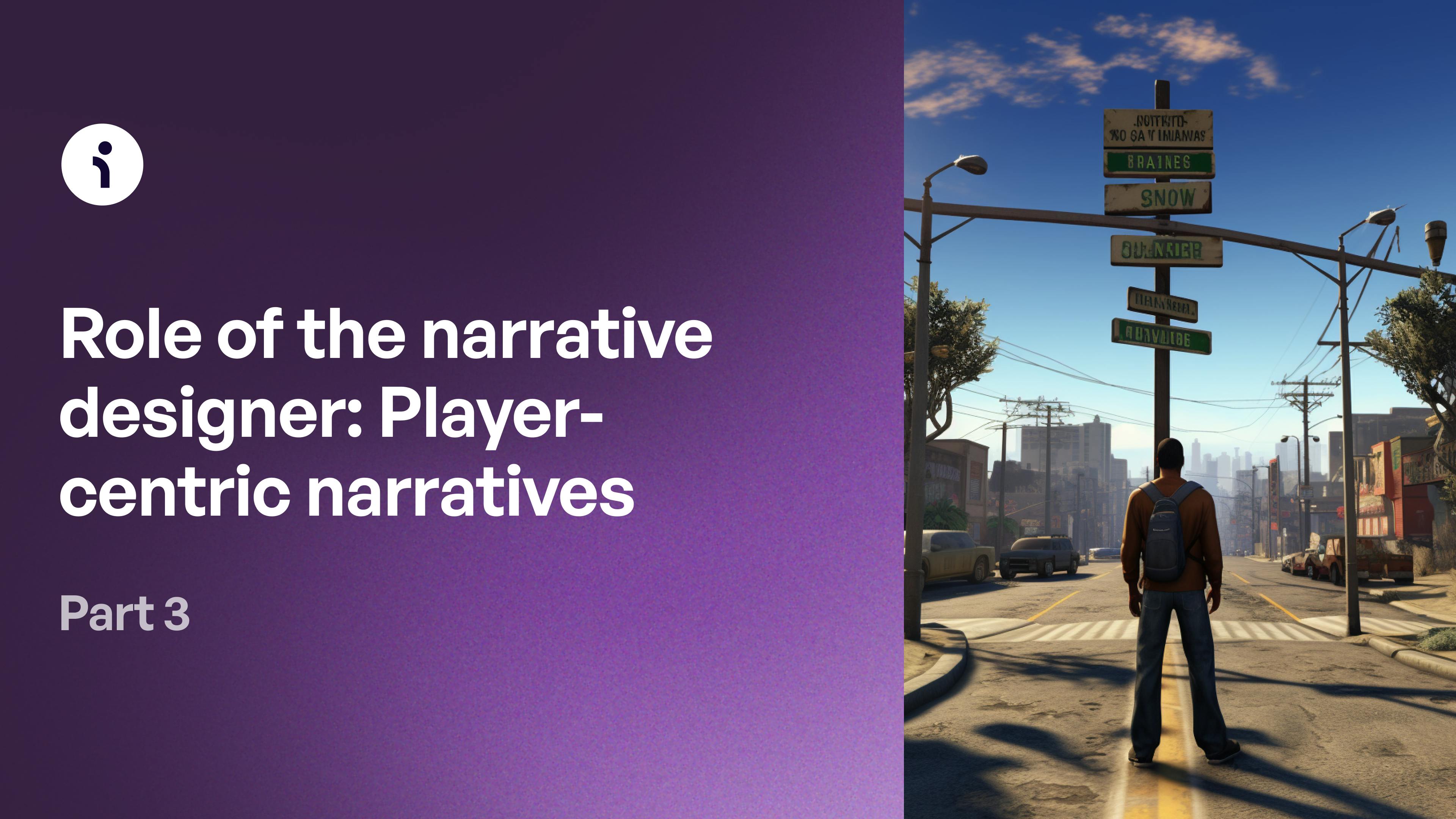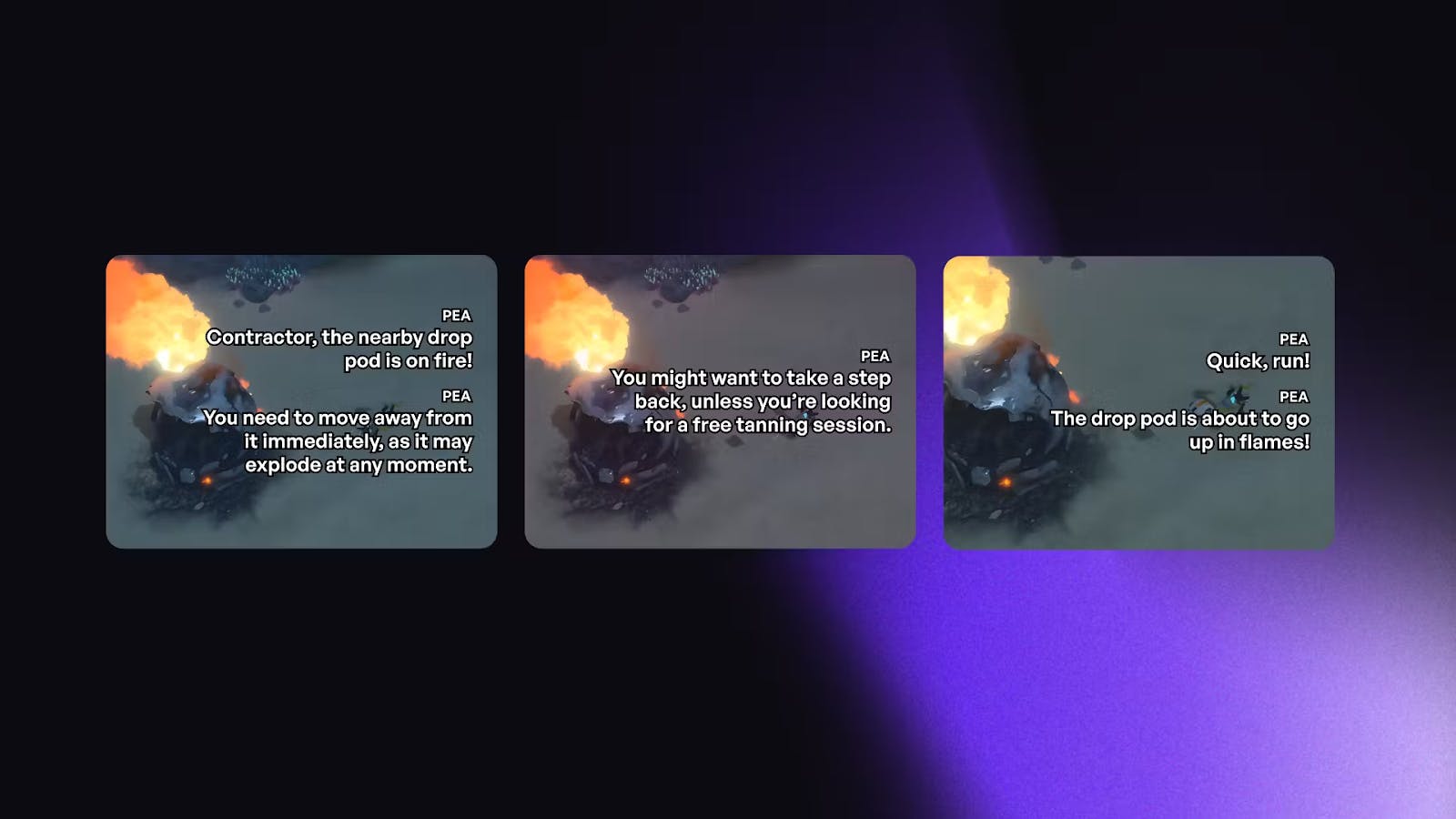Role of the narrative designer: Player-centric narratives

This is part 3 of a 3 part blog series examining the impact of AI NPCs on game narratives and narrative design. In this post, we examine how AI NPCs and player-centric design will shift narrative design. Read Part 1 and Part 2 here.
In this series, we’ve already examined the impact of player agency on player’s experiences of flow, session length, and replayability – and looked at how AI NPCs will enhance player agency in a number of transformational ways.
Now, we’ll do a deep dive into how the role of the narrative designer is set to shift – and give you example of how you might deploy AI NPCs to enhance player agency in different types of game narratives.
AI NPCs, player-centric narratives & narrative designers
How will AI NPCs and player-centric narratives affect the work of narrative designers and impact narrative design in games? With the increased focus AI NPCs bring to the nature and quality of NPC interactions, narrative design is set to become much more important. After all, the process of setting up AI NPCs involves a significant amount of narrative design and writing work.
From writing character descriptions and common world knowledge to scene descriptions, narrative designers and writers are critical to getting quality AI NPC performances. After all, AI NPCs are like actors who need direction around what role they’re playing, what they’re supposed to do, and what they know at different stages of the game narrative arc. AI NPCs then need to be tested and tweaked until they’re perfect.
Eva Jobse, the narrative designer for NetEase’s Cygnus Enterprises explained the shift in her role like this: “Rather than writing each distinct dialogue, it felt like I'd been put in the director's chair, outlining what I was looking for in broad strokes through adjusting character traits and motivations,” she explained. “I had to convey the key points of the world building and story to the AI and then let the AI take off from there.”
How player-centric should your game narrative design be?

An example of using AI NPCs to implement voice commands in an Action RPG
From the perspective of player-centric game narrative design, narrative designers will have more control over gamers’ experiences than ever. They’ll be the ones deciding how much player agency to give gamers via AI NPCs.
Do they want players to be able to customize AI NPC’s personalities or will that interfere with the game narrative too much? And if they do want to let players customize AI NPCs, in what ways? Any way gamers’ want? Or just along certain pre-chosen personality characteristics? What kinds of relationships do they want to allow gamers to have with NPCs? And will they use relationship progressions between AI NPCs and players as a trigger for a hint or action?
What kinds of technical functionalities will they give to their AI NPCs? The ability to act on voice commands? The ability to warn gamers of upcoming obstacles? Or the ability to answer ‘what’s that’ about anything in the game world?
What if they want to give gamers almost ‘unlimited agency’ in their game world? What guardrails will they put in place? How will they convey the game narrative via AI NPCs and in other ways?
With AI NPCs, the narrative designer becomes responsible for a wider range of game narrative design choices and work. A big part of their role when incorporating AI NPCs will involve finding the best way to implement them that fits the video game’s narrative structure and goals. That can vary greatly depending on the game narrative in question.
AI NPCs & scripted dialogue
Using AI NPCs in a game also doesn’t mean doing away with all scripted dialogue. For example, NetEase’s Action RPG Cygnus Enterprises, which incorporated Inworld’s AI NPCs, had dual dialogue systems – one with scripted narrative and another with AI NPCs. Players were able to toggle between them.
Character Engines like Inworld’s also allow narrative designers to script key dialogue with Goals and Actions triggers. NPCs can be prompted by dialogue-based or game-based triggers to say a line of written dialogue verbatim. Scripted triggers can be used to move the game narrative forward at key points or a narrative designer can choose to instead create triggers where the NPC has to deliver a message but it chooses the exact wording.
Games will likely use many different strategies around incorporating AI NPCs. The narrative designer might have them only for onboarding characters, others might have them for a few key characters, still others could switch scene by scene between AI NPCs and scripted NPCs depending on how narrative focused the scene is.
AI NPCs: A new tool in the game narrative design toolbox

Three examples of dialogue generated based on the goal trigger to warn the player the drop pod is about to explode
Just like cutscenes and dialogue trees are seen as different mediums to convey the game narrative, so too will be AI NPCs. Narrative designers will be responsible for deciding when best to deploy them – and just how player-centric they want their games to be.
What’s different is the amount of player agency gamers can have. Not only can they impact the game narrative by what they say or ask AI NPCs – they will also get variability between playthroughs. Above are three in-game dialogues generated in Cygnus Enterprises from the same trigger telling the PEA, the game’s companion character, to warn the player that the drop pod was about to explode. As you can see, this type of dynamic content can greatly improve replayability.
Player-centric narratives & game narrative types
While player-centric narratives seem particularly aligned with emergent and enacted narratives, AI NPCs can add more player-centricity and agency to all existing game narratives.
Here are some examples of how AI NPCs can be used in each narrative type:
AI NPCs and embedded narratives

Games that primarily use embedded narratives like Uncharted, The Last of Us, Gone Home, Pokemon: X, and The Walking Dead are known for their linear, plot-driven game storylines. The strength of the narrative direction drives players to keep playing in order to unravel the next part of the plot but the lack of player agency often frustrates gamers – and reduces replayability.
Research shows that, in completely linear game narratives, giving gamers player agency over small things can bolster a player’s sense of agency. AI NPCs can be used to personalize the game to the player and give them more of a sense of control – without taking away from the well-crafted linear plot.
That could mean using them as onboarding characters, making only certain NPCs AI NPCs, leveraging them via side quests, or using them during non-critical moments in the narrative.
AI NPCs and emergent narratives

Games that primarily use emergent narratives like Minecraft, Civilization, The Elder Scrolls V: Skyrim, No Man’s Sky, State of Decay, The Sims, and Dwarf Fortress are known for the freedom they give players to co-create the game narrative with the game’s mechanics and dynamics. This generates novel gameplay and narratives as a direct result of the player’s choices and actions.
AI NPCs are a perfect fit for emergent narratives. The ability to customize AI NPCs in real-time means that players can have significantly more control over shaping their emergent narratives. For emergent narratives in RPGs like Civilization, something like choosing your generals’ personalities is a great way to make a war game more immersive and fun. In emergent narrative games like Minecraft, AI NPCs would help make these worlds and experiences more real and dynamic – and greatly up replayability.
AI NPCs and enacted narratives

Games that primarily use enacted narratives like Life is Strange, Deus Ex: Invisible War, Fallout, and Red Dead Redemption II are similar to emergent narratives in that they’re focused on enhancing player agency. While players also co-create the narrative in enacted narratives, the player does so by acting the story out through gameplay, cutscenes, and quests.
AI NPCs are a great fit for enacted narratives since they’re games defined by meaningful game play choices that have an impact on the narrative of the game and its ultimate outcome through branching paths. AI NPCs offer the opportunity to immerse the player even more in the world and give them a greater sense of enacted agency on both their moment-to-moment gameplay and the greater narrative. The fact that gameplay can be completely different each playthrough because of this greatly increases a game's replayability.
Why choose Inworld as a narrative designer?
Our goal is to give narrative designers new tools and mediums to tell their game narratives – while giving gamers more of the player agency which drives key metrics like session length and replayability. AI NPCs can be a great addition to both games with linear narratives and games which rely on the gamer to co-create the narrative.
Gamers are excited to see all the ways narrative designers will implement AI NPCs to enhance the player experience and tell great game stories. Research we conducted with 1,000 gamers showed:
- 99% felt AI NPCs would enhance gameplay
- 78% felt like they would spend more time playing
- 79% would be more likely to buy a game
Curious about AI NPCs? Check out our Case Studies to see how they’ve been used in games – and sign-up for our Studio today!